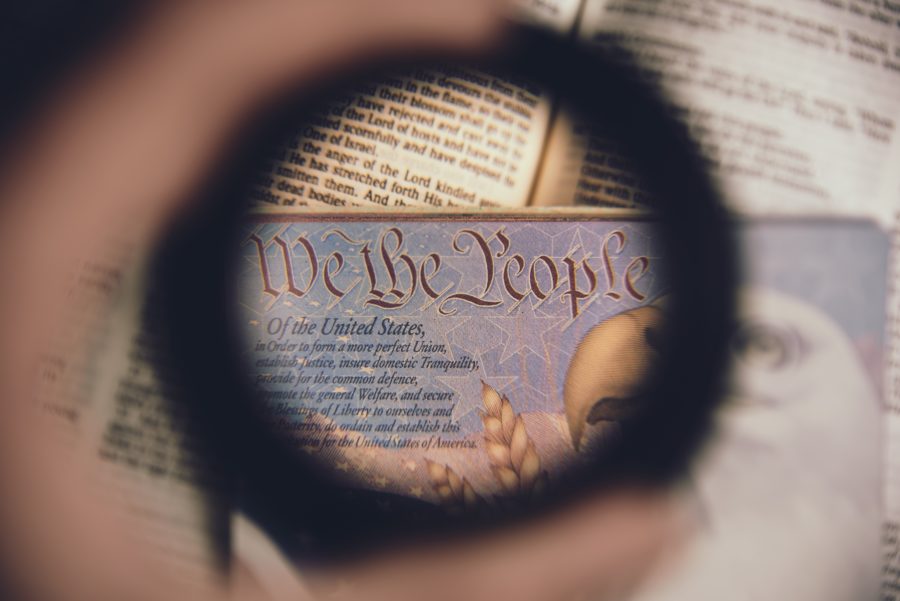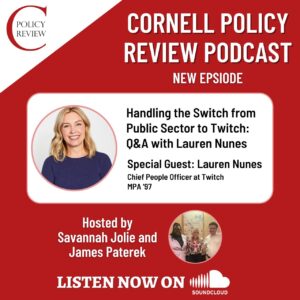
Written by: Adam Terragnoli
Edited by: Kathleen Egan
Introduction: A Modern Crisis of Confidence
“All politics is local,” a political mantra in the United States coined by Former Speaker of the House Tip O’Neill, argues that national decision-making starts on a local level.[1] Across the U.S., citizens gather in town halls, march on sidewalks, and organize in front of government buildings to debate the issues affecting their community and country. However, many Americans do not know how their own government works. In a survey conducted on Constitution Day, one third of Americans could not name a single branch of the federal government, twenty-seven percent were able to name one, and only twenty-six percent were able to name all three.[2] One in ten were able to identify “Assembly” – the freedom exercised when engaging in political discourse – as one of the five freedoms secured in the First Amendment.
Abraham Lincoln declared the U.S. government to be “of the people, by the people, [and] for the people,” yet “the people” do not know how their government works. This modern crisis of confidence is not irreparable; citizens can learn about the structure and function of government. In a country where an educated citizenry is an essential aspect of government, the U.S. can take steps to prioritize civics education to ensure that graduating seniors have a demonstrated mastery of how their government works. The National Council for the Social Studies (NCSS) defines civics education as “the knowledge of the history, principles and foundations of American democracy, and the ability to participate in civic and democratic processes.”[3]
Federal Influence on Education
The responsibility to provide public education can be found in U.S. state constitutions, which effectively creates one of the most decentralized systems of education in the world.[4] On a typical school day in the U.S., fifty million students sit in front of three million teachers, in 100,000 schools, residing in 15,000 districts.[5] By law, the U.S. federal government cannot impose curricula on states or school districts. Yet, federal legislation heavily influences what occurs inside of classrooms across the country.[6] For example, after the No Child Left Behind (NCLB) Act was signed into law in 2001, schools prioritized high-stake testing in reading and math to improve student learning.
In addition to testing, the Science Technology Engineering and Mathematics (STEM) movement, which has dominated discussions about postsecondary education and career readiness, is the result of the federal push for America’s ability to compete with educational systems around the world. The United States’ emphasis on STEM dates back to the Soviet Union’s launch of Sputnik in 1957. As the satellite traveled around the globe, the U.S. responded by passing the National Defense Education Act (NDEA), infusing over a billion dollars into math and science education.[7] Nearly sixty years later, the Obama administration released The Next Generation Science Standards, developing science and engineering practices for students from kindergarten to twelfth grade.[8] In June 2018, the Trump administration held a STEM Education summit, promoting the nation’s commitment to STEM,[9] and highlighting an executive order that seeks to expand STEM resources.[10]
The Effects of High-Stake Testing on Civics Education
Architects of the No Child Left Behind Act (NCLB) promised high curricular standards, quality testing, and an accountability system that would lead all students to proficiency in reading and math by 2014.[11] Improving these test scores was not only emphasized; it was incentivized. Schools and districts were penalized for failing to meet annual growth targets but were responsible for delivering state-created tests.[12] Districts across the country fixated solely on improving scores by “teaching to the test” to meet student growth requirements in the law, which had profound effects on instructional decision-making. More time was spent teaching subjects with a required state examination, and as a result, civics suffered. Tested subjects – such as reading and math – were found “diverting significant amounts of time” away from civics instruction.[13] Elementary and middle schools, in particular, were found curbing instructional time dedicated to civics courses in pursuit of achieving higher scores.[14] The greatest reduction in civics instruction has been found in elementary schools with higher minority populations.[15]
In 2015, the Every Student Succeeds Act (ESSA) replaced NCLB, but did not eliminate testing requirements. Part of ESSA allows increased flexibility for states to include civics and other courses.[16] Despite this flexibility, a 2018 survey conducted by the Education Week Research Center found fewer than one third of all public schools offer a stand-alone civics course. Varying in availability based on grade level, stand-alone civics courses are offered in only three percent of elementary schools, twenty-three percent of middle schools, and fifty-four percent of high schools. [17] Over half of the principals, assistant principals, and school leaders that were surveyed said their school dedicated “too little” time to civics education.
The Effect of the STEM Movement on Civics Courses
To increase college and career readiness and improve America’s competitiveness, the United States has become fixated on STEM education. Expanding upon the investment in STEM during the Obama administration,[18]President Trump directed the U.S. Department of Education to commit $200 million annually to support STEM.[19]
A 2018 report published by the Brookings Institution shows that the U.S. government is ostensibly getting what it is paying for, with math scores increasing “substantially” for students in fourth and eighth grades. [20] Reading scores have also been improving, but at a more modest rate compared to math.
Comparatively, according to the National Assessment of Educational Progress (NAEP), a congressionally funded project that collects data on civics education at the national and state levels, proficiency in civics trails behind.[21] According to their 2010 report, seventy-six percent of high school seniors did not achieve a “proficient” civics score. Since 1998, average proficiency scores for seniors have declined, and eighth grade scores remained stagnant. Examples of displaying “proficient” civics knowledge would be identifying the purposes of the U.S. Constitution, recognizing a role performed by the Supreme Court, and defining the term “melting pot” in the U.S.
Closing the Civics Gap
The Every Student Succeeds Act (ESSA) encourages states to include other courses, such as civics, as a “commitment to a well-rounded education.”[22] Students that enroll in civics courses are better informed about current issues, more knowledgeable about government, and more likely to vote.[23] With the prevalence of news from unreliable sources in a digitized era, misinformation and propaganda can sway voting decisions. Innovative civics education that considers literacy in news media can teach students the skills they need to distinguish between real and fake news.[24]
Researchers found that the presence of a standardized end-of-year test influences how much time is allotted for the instructional time of certain subjects.[25] Since virtually all educational decisions are made at the state level, states must decide whether they will require graduating seniors to pass an exam illustrating their proficiency in civics and government.
In 2014, the Joe Foss Institute created the Civics Education Initiative (CEI) in response to the civics crisis.[26] The CEI pushes for all high school seniors to pass a civics test as a requirement for graduation. The test is comprised of 100 basic facts derived from the same test administered to immigrants applying for U.S. citizenship. National Public Radio Education (nprED) has created a tool that compares state-by-state civics education requirements.[27] The tool shows the extent to which civics is required for high school graduation, current legislation being considered, and if the state has an exam modeled after the test for U.S. citizenship. In 2015, Arizona and North Dakota became the first two states to pass CEI legislation requiring students to pass a civics test. Since its inception, twenty-seven states have adopted a version of CEI legislation, and two other states proposed similar legislation in 2018.[28] As of 2017, eighteen states have rejected CEI legislation. Opponents disagree with the premise that requiring this test would improve civic competencies, and that some teachers will be inclined to teach to the test, therefore lowering expectations for students.
With or without mandated civics tests, teachers can use the work of nonpartisan institutions to expose students to important civics topics. Everyday Democracy, a national nonpartisan organization, produced the “Resource List for Teaching Civics and Government,”[29] a resource intended to assist elementary and secondary teachers with integrating civics topics into lessons and to provide information on organizations working on civics-related projects.[30] The list is comprised of forty-seven resources ranging from the American Bar Association to the Youth Leadership Initiative at the University at Virginia.
“As civic learning has been pushed aside, society has neglected a fundamental purpose of American education, putting the health of our democracy at risk.” – Sandra Day O’Connor (Former Supreme Court Justice)[31]
Equipping America’s students with the knowledge needed to compete globally is undoubtedly a worthy goal, but not when it comes at the cost of neglecting civics education. The Brown Center on Education Policy at the Brookings Institution concluded that “schools, more than any other public institution, are tasked with developing Americans’ civic knowledge, skills and dispositions… Research indicated the schools that make a concerted effort to increase civic participation can, in fact, do so.”[32] The U.S. is a “melting pot” that is the sum of its parts, founded on the idea that “the people” have a voice in government. As teachers in America educate the scholars of the future, it would be wise to listen to the words of educational reformer John Dewey: “if we teach today’s students as we taught yesterday, we rob them of tomorrow.”[33] By continuing to neglect civics, students in America are robbed of the education that will make them the citizens their country needs.
References
- O’Neill, Tip, and Gary Hymel. “All politics is local.” New Times (1994). ↑
- “Constitution Day Civics Survey” Annenberg Public Policy Center. (2017) https://cdn.annenbergpublicpolicycenter.org/wp-content/uploads/2017/09/Appendix_Civics_survey_2017.pdf;. “Americans Know Surprisingly Little About Their Government.” Annenberg Public Policy Center (2014) http://www.annenbergpublicpolicycenter.org/americans-know-surprisingly-little-about-their-government-survey-finds/ ↑
- National Council for the Social Studies, “Career and Civic Life: C3 Framework for Social Studies State Standards.” (2013) http://www.socialstudies.org/sites/default/files/c3/ C3-Framework-for-Social-Studies.pdf ↑
- McCabe, Lisa A., and John W. Sipple. “Colliding worlds: Practical and political tensions of prekindergarten implementation in public schools.” Educational Policy 25, no. 1 (2011): e1-e26. ↑
- The NCES Fast Facts Tool provides quick answers to many education questions (National Center for Education Statistics). (n.d.). https://nces.ed.gov/fastfacts/display.asp?id=372 ↑
- Ravitch, Diane. The death and life of the great American school system: How testing and choice are undermining education. Basic Books, 2016. ↑
- All Things Considered “Sputnik Left Legacy for U.S. Science Education.” NPR, September 30, 2007. https://www.npr.org/templates/story/story.php?storyId=14829195 ↑
- “Final Next Gen Science Standards Released.” Next Gen Science, April 13, 2009. https://www.nextgenscience.org/news/final-next-generation-science-standards-released ↑
- https://www.whitehouse.gov/wp-content/uploads/2018/06/Summary-of-the-2018-White-House-State-Federal-STEM-Education-Summit.pdf ↑
- https://www.whitehouse.gov/articles/president-trump-signs-memorandum-stem-education-funding/ ↑
- Ibid Ravitch 2016. ↑
- Jennings, J. “Presidents, congress, and the public schools: The politics of education reform.” Cambridge, MA: Harvard Education Press, 2015 ↑
- von Zastrow, Claus Eric, and Helen Janc. Academic atrophy: The condition of the liberal arts in America’s public schools. Council for Basic Education, 2004. ↑
- West, Martin. “Testing, learning, and teaching: The effects of test-based accountability on student achievement and instructional time in core academic subjects.” Beyond the Basics: Achieving a Liberal Education for All Children, ed. Chester E. Finn, Jr., and Diane Ravitch (Washington, DC: Thomas B. Fordham Institute, 2007) (2007): 45-61. ↑
- Rothstein, Richard, and Rebecca Jacobsen. “The goals of education.” Phi delta kappan 88, no. 4 (2006): 264-272 ↑
- Brennan, Jan. “ESSA: Mapping Opportunities for Civic Education. Education Trends.” Education Commission of the States (2017). ↑
- Kurtz, Holly, Sterling Lloyd, Alex Harwin, and Michael Osher. “Civics Education in K-12 Schools. Results of a National Survey.” Editorial Projects in Education (2018). ↑
- Barack Obama. “Remarks by the president in the state of the union address.” Washington D.C.: The White House. (January 27th, 2010). http://www.whitehouse.gov/the-press-office/remarks-president-state-union-address ↑
- “Trump Orders Education Department to Prioritize STEM & Computer Science Activities.” (July 31, 2018). https://www.aip.org/fyi/2017/trump-orders-education-department-prioritize-stem-computer-science-activities ↑
- Hansen, M., Levesque, E., Valant, J., & Quintero, D. “The 2018 Brown Center Report on American Education: How Well are American Students Learning.” (2018). ↑
- “Civics 2010: National Assessment of Educational Progress at Grades 4, 8, and 12.” National Center for Education Statistics, 2010. https://nces.ed.gov/nationsreportcard/pdf/main2010/2011466.pdf ↑
- Ibid Brennan 2017 ↑
- Kawashima-Ginsberg, Kei, and Peter Levine. “Policy effects on informed political engagement.” American Behavioral Scientist 58, no. 5 (2014): 665-688. ↑
- Wineburg, Sam, Joel Breakstone, Sarah McGrew, and Teresa Ortega. “Evaluating Information: The Cornerstone of Online Civic Literacy; Executive Summary.” (2016). ↑
- Grant, S. G. “High-stakes testing: How are social studies teachers responding?” In Social Studies Today, pp. 53-62. Routledge, 2015. ↑
- Brennan, Jan and Hunter Railey “The Civics Education Initiative 2015-17” (2017). https://www.ecs.org/wp-content/uploads/The-Civics-Education-Initiative-2015-2017.pdf ↑
- Cardinali, E. (2018, July 21). “What Your State Is Doing To Beef Up Civics Education.” (July 21, 2018) https://www.npr.org/sections/ed/2018/07/21/624267576/what-your-state-is-doing-to-beef-up-civics-education ↑
- Diana E. Hess, Sam Stone and Joseph Kahne, “Should High School Students be Required to Pass a Citizenship Test?,” Social Education, vol. 79, no. 4, (2015), 173- 176, https://www.socialstudies.org/publications/ socialeducation/september2015/should_high_ school_students_be_required_to_pass_a_ citizenship_test (accessed August 1, 2017); The Center for Information and Research on Civic Learning and Engagement, “More than a Test: Truly Committing to Civic Education,” CIRCLE Blog, 2015, http://civicyouth. org/more-than-a-test-truly-committing-to-civic- education/ ↑
- Coughlin, Daniel. “Resource List for Teaching Civics and Government” Everyday Democracy, (2015) https://www.everyday-democracy.org/sites/default/files/attachments/Resource-List-for-Civics-Teachers.pdf ↑
- Daniel Coughlin. “Everyday Democracy: Resource List for Teaching Civics and Government.” (2015) https://www.everyday-democracy.org/sites/default/files/attachments/Resource-List-for-Civics-Teachers.pdf ↑
- “Call to Action,” Campaign for the Civic Mission of Schools, April 17, 2006, www.civicmissionofschools.org ↑
- Ibid Hansen et al., 2018. ↑
- John Dewey. “Democracy and education: An introduction to the philosophy of education.” New York: Macmillan. (1916) ↑





